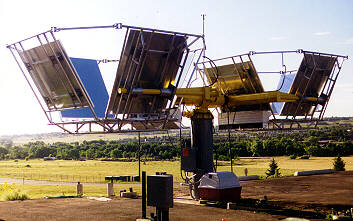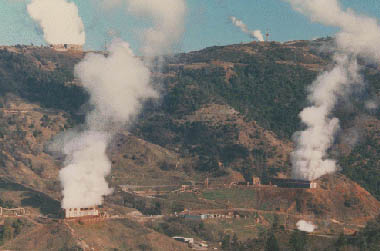Here's a quick look at some renewable energy systems that are developing as well as a few links to more information...
| Photovoltaic
(PV) Cells - convert sunlight into electricity using semi-conductor
materials. Your solar calculator and satellites are powered by PV cells.
So is this roadside emergency call box. Find out more at:
|
|
||
 Solar
Thermal Systems use heat from the sun to generate electricity
or the heat may also be used directly to heat water or space. Solar energy
is suitable for use just about anywhere in Texas. The best sites are located
in West Texas where one acre of and can produce the equivalent of 800 barrels
of oil a year. All the electricity Texans need in one year could be provided
by dedicating one mid-sized Texas county (Upton County) to solar electric
generating stations. If an area the size of the South Texas Nuclear Project
(12,000) was used for a solar electric generating station, it would provide
the same amount of power --- 2,000 megawatts. Solar
Thermal Systems use heat from the sun to generate electricity
or the heat may also be used directly to heat water or space. Solar energy
is suitable for use just about anywhere in Texas. The best sites are located
in West Texas where one acre of and can produce the equivalent of 800 barrels
of oil a year. All the electricity Texans need in one year could be provided
by dedicating one mid-sized Texas county (Upton County) to solar electric
generating stations. If an area the size of the South Texas Nuclear Project
(12,000) was used for a solar electric generating station, it would provide
the same amount of power --- 2,000 megawatts. Enron Corporation, the world's largest natural gas company, proposes to sell solar-produced electricity to the U.S. Government for 5.5cents/kilowatt hour -- 2 cents less than average cost. See: http://www.Austin360.com/greenzone/treia/ and http://www.teleport.com/~chrisdb/project/#solarplants |
|||
|
Wind Turbines - use space age technology
to capture the force of the wind to generate electricity. |
|
||
|
Biomass Systems - use energy crops
like fast growing trees, industrial wood waste, organic landfill waste
or landfill gas to generate electricity. |
|
||
 |
Geothermal energy is renewable
heat energy from deep in the earth. Heat is brought to the near-surface
by thermal conduction and by intrusion into the earth's crust of molten
magma originating from great depth. Ground water is heated to form hydrothermal
resources -- naturally occurring hot water and steam. Use of hydrothermal
energy is economic today at a number of high-grade sites. Hydrothermal
resources are tapped by existing well-drilling and energy-conversion technology
to generate electricity or to produce hot water for direct use. For
more information see: |
 |
but is No. 50 (dead last!) its in use of renewable energy. |
![]()
![]()
|
|
|
|
|
|
|
Pollutant emissions produced by photovoltaic, solar thermal, wind and biomass energy are insignificant when compared to fossil and nuclear power production. |
POLLUTANT EMISSION FACTORS FOR ELECTRICAL GENERATION
THE TOTAL FUEL CYCLE (g/kWh)
(Source: Texas Renewable Energy Industries Association, P.O. Box 16469, Austin, Texas 78761-6469. )
| Energy Source | CO2 | NOx | SOx |
| Coal | 322.8 | 1.800 | 3.400 |
| Oil | 258.5 | 0.880 | 1.700 |
| Natural gas | 178.0 | 0.900 | 0.001 |
| Nuclear | 7.8 | 0.030 | 0.030 |
| Photovoltaic | 5.3 | 0.007 | 0.020 |
| Solar Thermal | 3.3 | Trace | Trace |
| Wind | 6.7 | Trace | Trace |
| Biomass (with fuel regrowth program) | 0.01 | 0.600 | 0.140 |
|
|
|
|
|